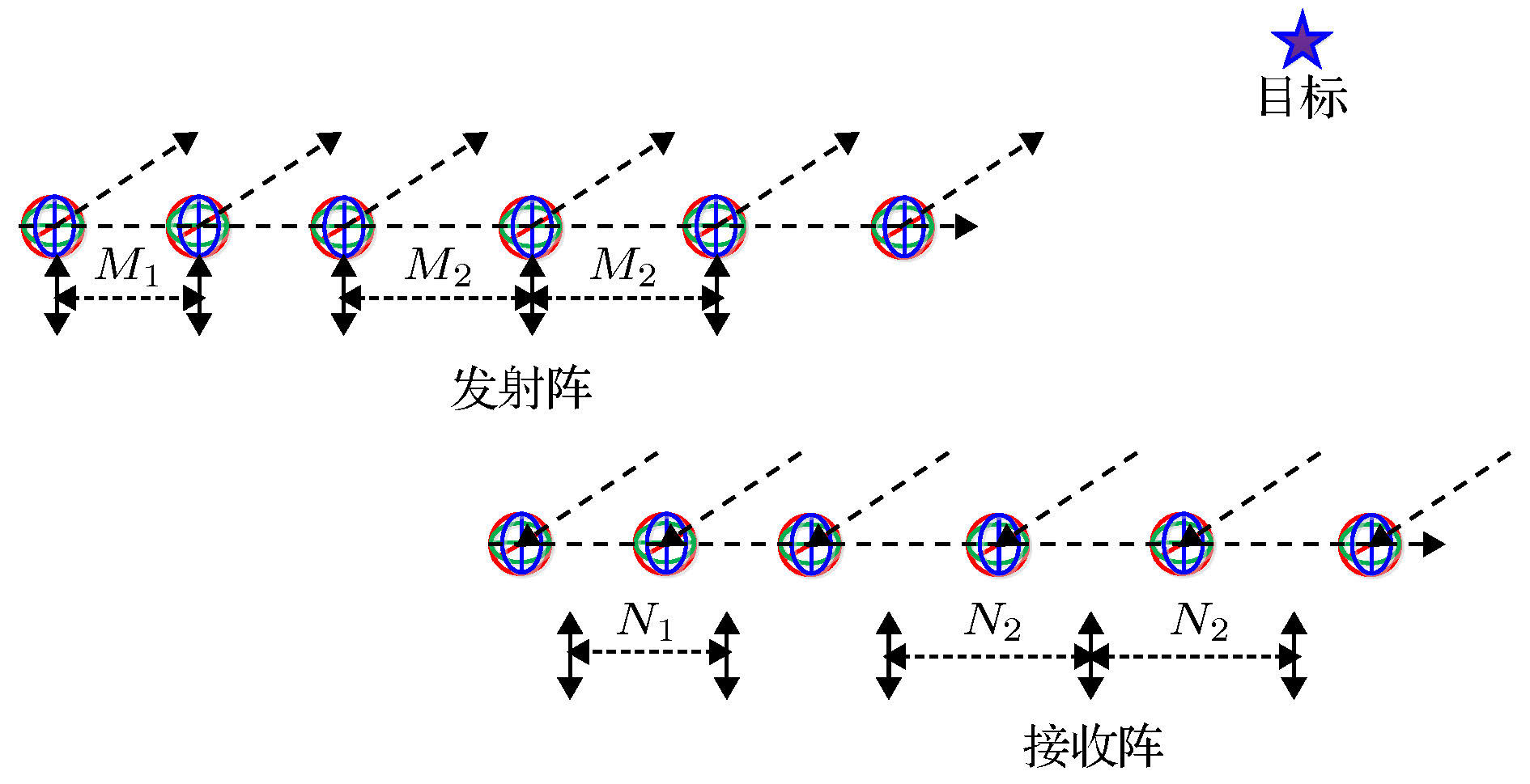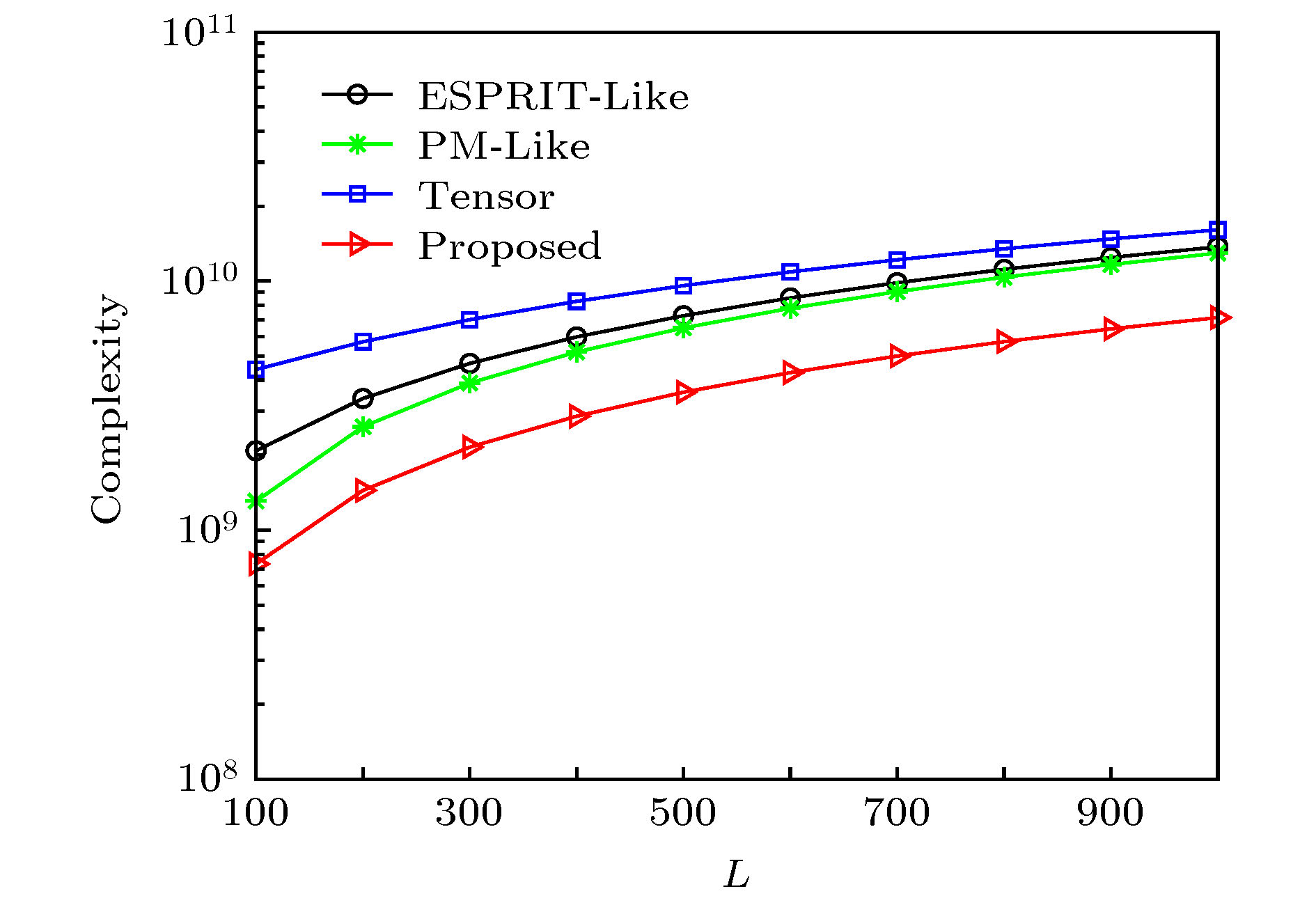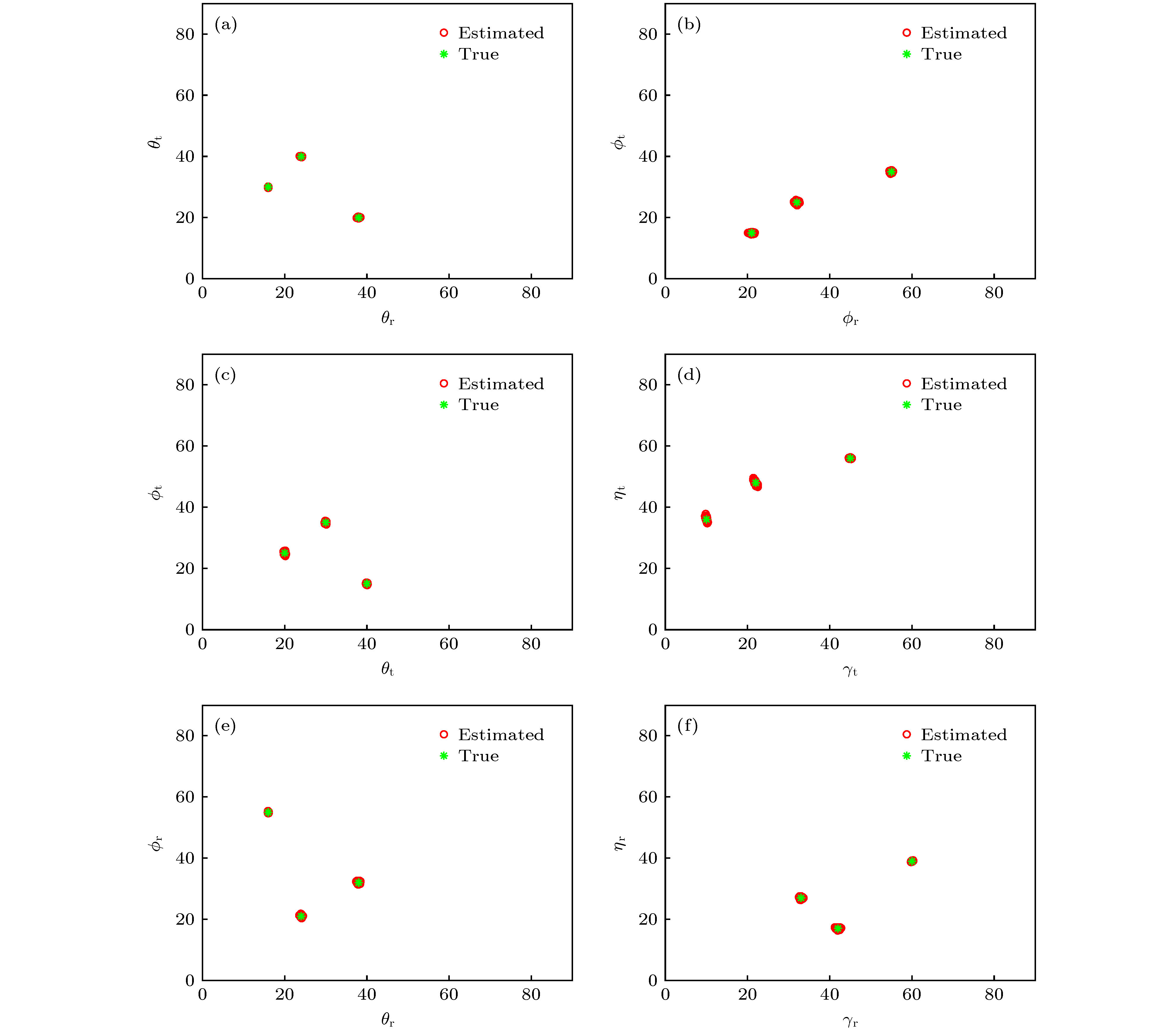-
In this paper, a new sparse transmitting and receiving array is designed to improve the joint angle and polarization parameter estimation performance for bistatic electromagnetic vector sensors Multiple-Input Multiple-Output radar. Firstly, large array aperture can be obtained with the aid of the sparse transmitting and receiving array. Then, an effective third-order tensor model is constructed in order to make full use of the multidimensional space-time characteristics of output data after matching filtering. And, the Parallel Factor trilinear alternating least square algorithm is proposed to deal with the constructed third-order tensor model, which can yield closed-form automatically paired two dimensional Direction of Departure and two dimensional Direction of Departure estimation without additional angle pair matching process. Furthermore, two sets of high accuracy rotation invariance relationships corresponding to transmit elevation angle and receive elevation angle can be achieved by using the estimated transmit steering vector matrix and receive steering vector matrix. After the accuracy transmit elevation angle and receive angle are obtained, the corresponding transmitting and receiving azimuth angle, polarization angle and polarization phase difference can be accurately estimated by using the vector-cross-product algorithm. Compared with existing algorithms, the proposed algorithm can avoid high dimensional eigenvalue decomposition and additional parameter matching process. Moreover, the high estimation performance of the proposed can be further guaranteed by using the designed sparse array. Finally, simulation results demonstrate the effectiveness and superiority of the proposed method in terms of estimation accuracy and angle resolution.
-
Keywords:
- sparse array /
- bistatic electromagnetic vector sensors multiple-input multiple-output radar /
- parallel factor trilinear alternating least square /
- joint parameter estimation
[1] Wang X P, Wang L Y, Li X M, Bi G A 2017 Signal Process. 135 147
 Google Scholar
Google Scholar
[2] Wang X P, Wan L T, Huang M X, Shen C, Zhang K 2019 IEEE J. Sel. Topics Signal Process. 13 1001
 Google Scholar
Google Scholar
[3] Xie Q P, Pan X Y, Huang M, Chen J Y, Xiao S P 2019 IEEE Access 7 107805
 Google Scholar
Google Scholar
[4] Li J, Stoica P 2007 IEEE Signal Process. Mag. 5 106
[5] Zhang X F, Xu L Y, Xu L, Xu D Z 2010 IEEE Commun. Lett. 14 1161
 Google Scholar
Google Scholar
[6] Zhang X F, Xu D Z 2010 Electron. Lett. 12 860
[7] Chen D F, Chen B X, Qin G D 2008 Electron. Lett. 44 770
 Google Scholar
Google Scholar
[8] Chen J L, Gu H, Song W M 2008 Electron. Lett. 44 1422
 Google Scholar
Google Scholar
[9] Bencheikh M L, Wang Y D, He H Y 2010 Signal Process. 90 2723
[10] Xia T Q 2015 Signal Process. 108 159
 Google Scholar
Google Scholar
[11] Xia T Q 2015 Signal Process. 116 7
 Google Scholar
Google Scholar
[12] Wang X P, Wang W, Liu J, Liu Q, Wang B 2015 Signal Process. 116 152
 Google Scholar
Google Scholar
[13] Wen F Q, Xiong X D, Su J, Zhang Z J 2017 Signal Process. 134 261
 Google Scholar
Google Scholar
[14] Xu B Q, Zhao Y B 2019 Signal Process. 157 88
 Google Scholar
Google Scholar
[15] Li L, Younan N H, Shi X F 2019 Sensors 19 1
 Google Scholar
Google Scholar
[16] Chen J L, Zhou Q G, Li J Q, Zhu Y P 2019 IET Radar Sonar Navigat. 13 1180
 Google Scholar
Google Scholar
[17] Chen J L, Zhang T X, Li J Q, Chen X 2019 IEEE Sensors J. 19 5384
 Google Scholar
Google Scholar
[18] Wong K T, Zoltowski M D 1997 IEEE Trans. Antennas Propag. 45 1467
 Google Scholar
Google Scholar
[19] Chintagunta S, Ponnusamy P 2018 Signal Process. 147 163
 Google Scholar
Google Scholar
[20] Liu T T, Wen F Q, Shi J P, Gong Z H, Xu H 2019 IEEE Access 7 120533
 Google Scholar
Google Scholar
[21] Mao C X, Shi J P, Wen F Q 2019 IEEE Access 7 163119
 Google Scholar
Google Scholar
[22] Sidiropoulos N D, Bro R, Giannakis G B 2000 IEEE Trans. Signal Process. 48 2377
 Google Scholar
Google Scholar
[23] Stoica P, Nehorai A 1989 IEEE Trans. Acoust. Speech Signal Process. 37 720
 Google Scholar
Google Scholar
-
图 3 所提算法角度参数和极化参数估计星座图 (a) 发射俯仰角和接收俯仰角; (b) 发射方位角和接收方位角; (c) 发射俯仰角和发射方位角; (d) 发射极化角和极化相位差; (e) 接收俯仰角和接收方位角; (f) 接收极化角和极化相位差
Figure 3. Scatter plot of the angle parameters and polarization parameters by using the proposed method: (a) Scatter plot of the transmit elevation angle and receive elevation angle; (b) scatter plot of the transmit azimuth angle and receive azimuth angle; (c) scatter plot of the transmit elevation angle and azimuth angle; (d) scatter plot of the transmit polarization angle and polarization phase difference; (e) scatter plot of the receive elevation angle and azimuth angle; (f) scatter plot of the receive polarization angle and polarization phase difference.
表 1 不同算法的计算复杂度对比
Table 1. Computational complexity comparison of different methods.
算法类型 计算复杂度 计算时间/s ESPRIT-Like算法 [19] $\begin{aligned}& o((6 M)^2(6N)^2L + (6 M)^3(6 N)^3 + 2K^26(N + M - 2) + 6{K^3} \\ & + 7(M + N){K^2} + 12 K + 36 MN(36 MN - K) + (36 MN - K){K^2}) \end{aligned} $ 28.332 PM-Like算法 [20] $\begin{aligned}& o((6M)^2(6N)^2L + 72MN{K^2} + 2{K^2}6 (N + M - 2) + 6{K^3} \\& + 7( {M + N} ) {K^2} + 12K + 36MN({36MN - K}) + (36MN - K){K^2})\end{aligned} $ 2.0698 Tensor子空间算法 [21] $\begin{aligned} & o((6 M)^2(6N)^2L + 4(6M)^3(6N)^3 + 2K^2 6(N + M - 2) + 6{K^3} \\& + 7( {M + N} ) K^2 + 12 K + 36 MN( {36 MN - K} ) + (36 MN - K)K^2) \end{aligned} $ 109.880 所提算法 $\begin{aligned}& o(\kappa ( 3K^3+ 108 MNKL + 3K^2) + \kappa (3K^2(36 MN + 6 NL + 6 ML)) \\ & + 2{K^2}6({N + M - 2} ) + 6{K^3} + 7(M + N){K^2} + 12K) \end{aligned} $ 0.5684 表 2 目标回波参数表
Table 2. Parameters of target signals.
目标 方位角
θ/(°)俯仰角
ϕ/(°)极化角
γ/(°)极化相位差
η/(°)1 $40/24$ $15/21$ $10/42$ $38/17$ 2 $20/38$ $25/32$ $22/33$ $48/27$ 3 $30/16$ $35/55$ $45/60$ $56/39$ -
[1] Wang X P, Wang L Y, Li X M, Bi G A 2017 Signal Process. 135 147
 Google Scholar
Google Scholar
[2] Wang X P, Wan L T, Huang M X, Shen C, Zhang K 2019 IEEE J. Sel. Topics Signal Process. 13 1001
 Google Scholar
Google Scholar
[3] Xie Q P, Pan X Y, Huang M, Chen J Y, Xiao S P 2019 IEEE Access 7 107805
 Google Scholar
Google Scholar
[4] Li J, Stoica P 2007 IEEE Signal Process. Mag. 5 106
[5] Zhang X F, Xu L Y, Xu L, Xu D Z 2010 IEEE Commun. Lett. 14 1161
 Google Scholar
Google Scholar
[6] Zhang X F, Xu D Z 2010 Electron. Lett. 12 860
[7] Chen D F, Chen B X, Qin G D 2008 Electron. Lett. 44 770
 Google Scholar
Google Scholar
[8] Chen J L, Gu H, Song W M 2008 Electron. Lett. 44 1422
 Google Scholar
Google Scholar
[9] Bencheikh M L, Wang Y D, He H Y 2010 Signal Process. 90 2723
[10] Xia T Q 2015 Signal Process. 108 159
 Google Scholar
Google Scholar
[11] Xia T Q 2015 Signal Process. 116 7
 Google Scholar
Google Scholar
[12] Wang X P, Wang W, Liu J, Liu Q, Wang B 2015 Signal Process. 116 152
 Google Scholar
Google Scholar
[13] Wen F Q, Xiong X D, Su J, Zhang Z J 2017 Signal Process. 134 261
 Google Scholar
Google Scholar
[14] Xu B Q, Zhao Y B 2019 Signal Process. 157 88
 Google Scholar
Google Scholar
[15] Li L, Younan N H, Shi X F 2019 Sensors 19 1
 Google Scholar
Google Scholar
[16] Chen J L, Zhou Q G, Li J Q, Zhu Y P 2019 IET Radar Sonar Navigat. 13 1180
 Google Scholar
Google Scholar
[17] Chen J L, Zhang T X, Li J Q, Chen X 2019 IEEE Sensors J. 19 5384
 Google Scholar
Google Scholar
[18] Wong K T, Zoltowski M D 1997 IEEE Trans. Antennas Propag. 45 1467
 Google Scholar
Google Scholar
[19] Chintagunta S, Ponnusamy P 2018 Signal Process. 147 163
 Google Scholar
Google Scholar
[20] Liu T T, Wen F Q, Shi J P, Gong Z H, Xu H 2019 IEEE Access 7 120533
 Google Scholar
Google Scholar
[21] Mao C X, Shi J P, Wen F Q 2019 IEEE Access 7 163119
 Google Scholar
Google Scholar
[22] Sidiropoulos N D, Bro R, Giannakis G B 2000 IEEE Trans. Signal Process. 48 2377
 Google Scholar
Google Scholar
[23] Stoica P, Nehorai A 1989 IEEE Trans. Acoust. Speech Signal Process. 37 720
 Google Scholar
Google Scholar
Catalog
Metrics
- Abstract views: 12229
- PDF Downloads: 140
- Cited By: 0















 DownLoad:
DownLoad:





